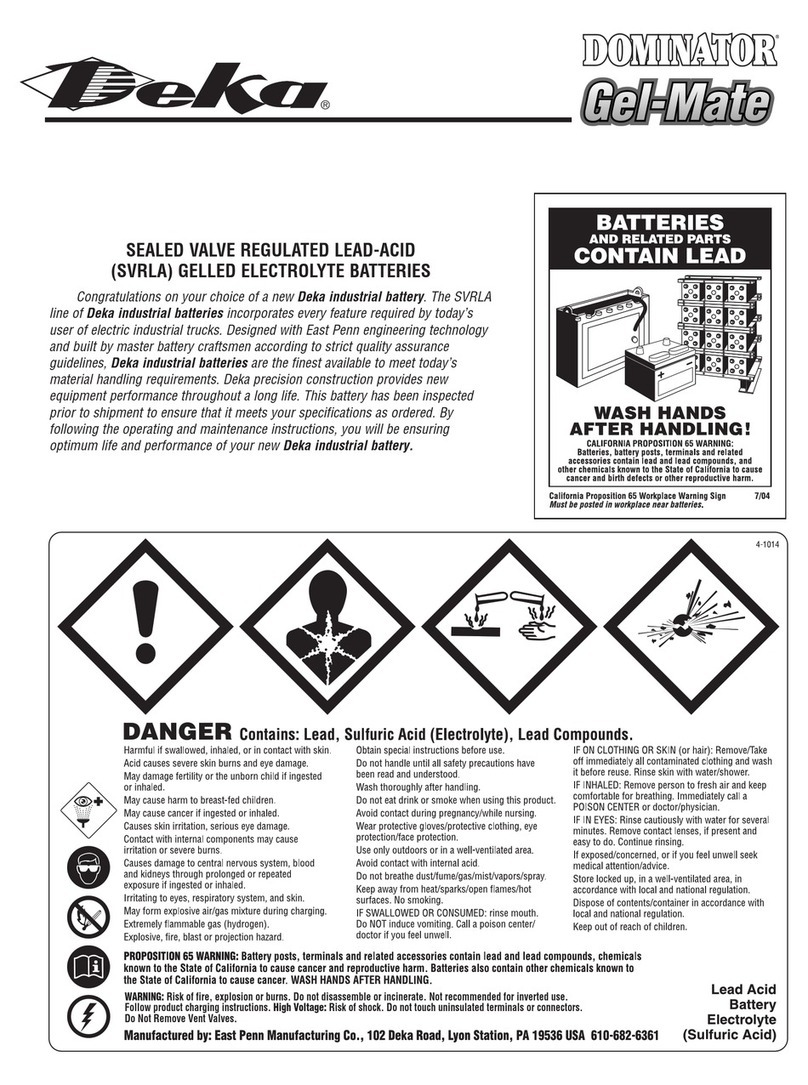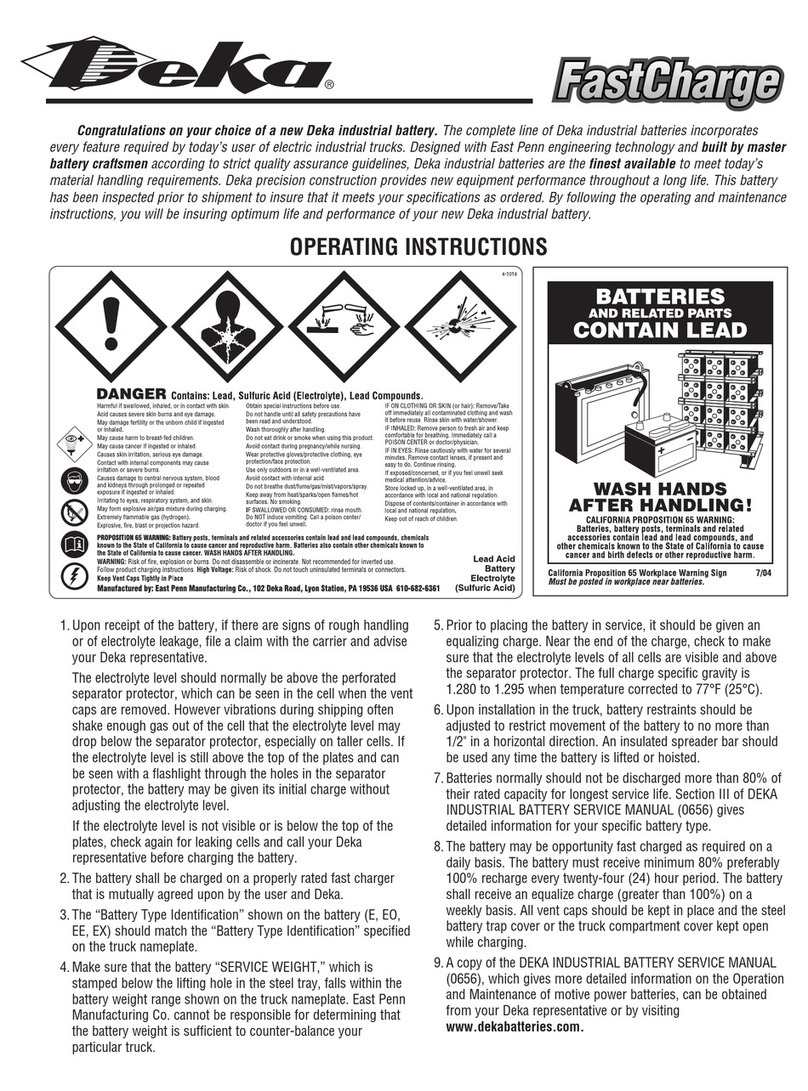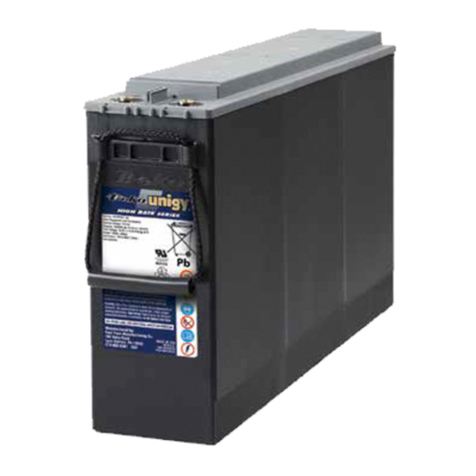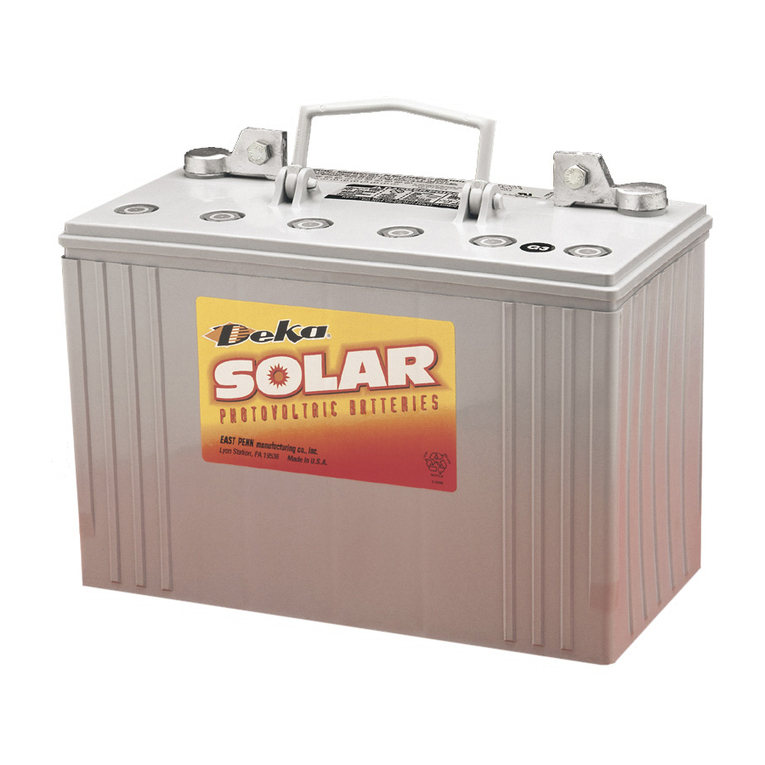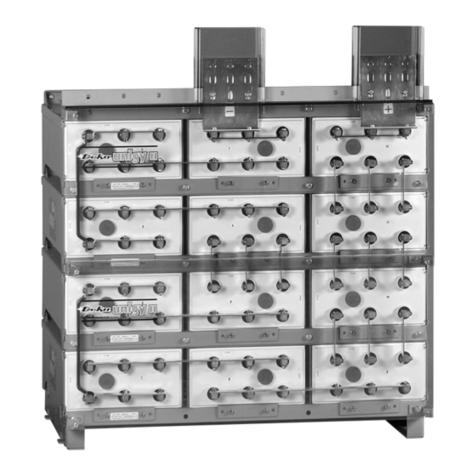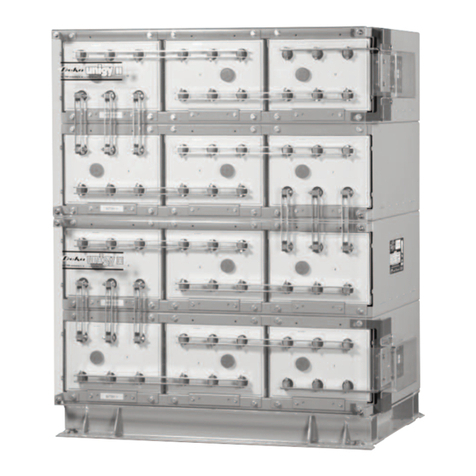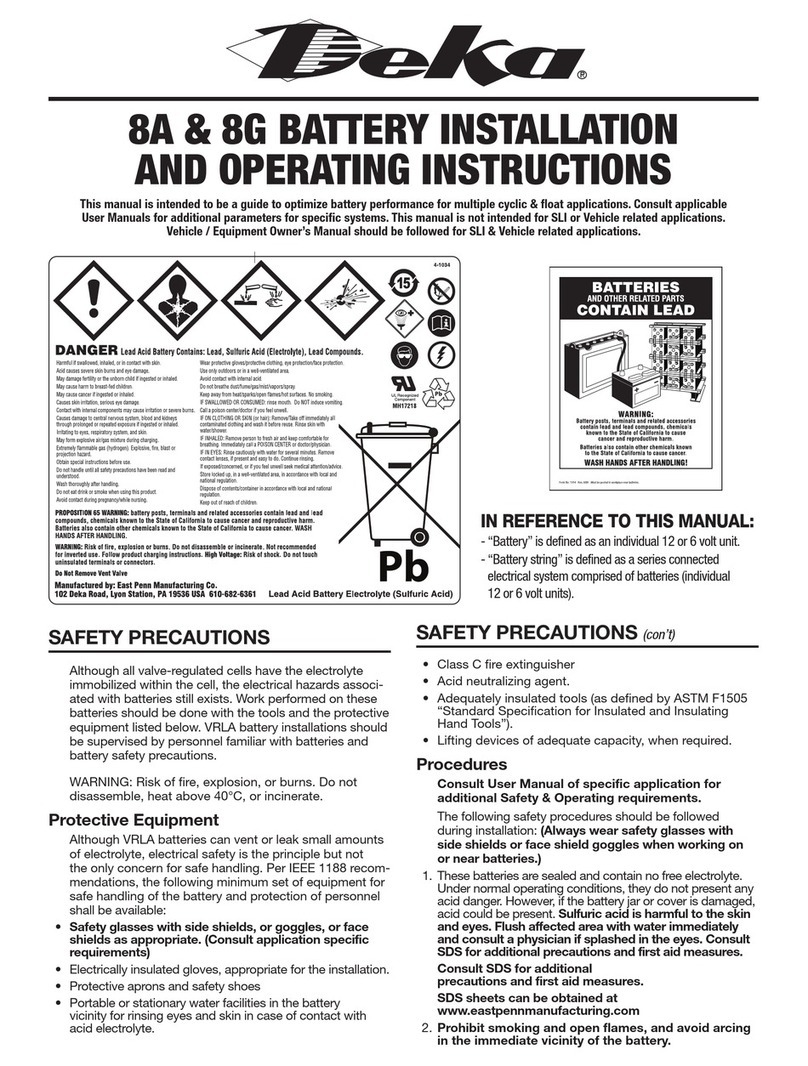
Danger
HYDRO EN AS FROM THE BATTERY OR CELL CAN
EXPLODE. DO NOT SMOKE, USE AN OPEN FLAME, OR
CREATE AN ARC OR SPARKS IN THE VICINITY OF INDI-
VIDUAL CELLS OR BATTERIES. VENTILATE WELL WHEN
IN AN ENCLOSED SPACE AND WHEN CHAR IN .
THIS BATTERY OR INDIVIDUAL CELL CONTAINS SULFU-
RIC ACID WHICH CAUSES SEVERE BURNS. DO NOT ET
IN EYES, ON SKIN OR ON CLOTHIN . IN CASE OF CON-
TACT, FLUSH IMMEDIATELY WITH CLEAN WATER.
OBTAIN MEDICAL ATTENTION IF EYES ARE AFFECTED.
PERSONAL SAFETY EQUIPMENT IS RECOMMENDED
WHEN WORKIN WITH BATTERIES AND SHOULD BE
USED IN ACCORDANCE WITH LOCAL REQUIREMENTS;
SAFETY LASSES, O LES OR A FACE SHIELD.
RUBBER OR PLASTIC LOVES AND A RUBBER OR PLAS-
TIC APRON ARE ITEMS OFTEN USED IN THIS TYPE OF
WORK. EQUIPMENT WHICH WILL PROTECT THE EYES
FROM ACID SPLASHES IS THE MOST IMPORTANT SINCE
THE EYES CAN BE SERIOUSLY AFFECTED IN A VERY
SHORT TIME.
Ampere Hour (AH)
The electrical capability of a storage battery is usually
expressed in ampere-hours. The ampere-hour capacity is the
number of ampere-hours which can be delivered under speci-
fied conditions of temperature, rate of discharge, and final
voltage. Basically, ampere-hours are determined by multiplying
the number of amperes which the battery will deliver by the
number of hours during which the current is flowing. Example:
100 amperes x 6 hours to 1.70 volts per cell = 600 ampere-
hours (six hour rate). The size and number of plates which
make up the element then determine total cell or battery capaci-
ty. Due to the variety of job requirements batteries are
produced with many different sizes of cells.
Kilowatt Hours (KWH)
Battery capacity is also expressed in kilowatt-hours (KWH),
which is the product of ampere x time x average volts per cell
during discharge. Example: 100 amps x 6 hours x 1.930 aver-
age volts per cell = 1,158 watt hours ÷ 1000 = 1.158 KWH. For
an 18-cell battery, the capacity would be 1.158 x 18 = 20.84
KWH. Increasing or decreasing the size of the cells or the num-
ber of cells in the battery can vary the kilowatt-hour rating.
Positive Plate Capacity
Positive plate capacity is the ampere delivery for a fixed period
of time (usually six hours) for a particular size positive plate. A
Deka D100 type positive plate has the capability of delivering
16.66 amperes for six hours or 100 ampere hours (16.66 x 6 =
100 AH) to a final voltage of 1.70. Increasing or decreasing the
number of positive plates in the cell can vary this ampere-hour
rating or capacity. In the previous examples, the battery is an
18-cell, D100-13 plate unit. To determine the number of positive
plates in each cell, subtract one from the total number of plates
in the cell and divide by two. Example: 13 – 1 = 12 ÷ 2 = 6 posi-
tive plates per cell; 6 positive plates x 100 ampere-hours each =
600 AH. The use of a different type of positive plate, such as a
D75 or D125, will respectively decrease or increase the
ampere-hour capacity. The above ratings are based on an elec-
trolyte temperature of 77°F/25°C with a full charge specific
gravity at battery nameplate rating.
Specific Gravity
The term specific gravity describes the ratio of the density of
electrolyte to the density of water. Electrolyte weighing 1.2
times as much as the same volume of water has a specific
gravity of 1.200. The full charge specific gravity of a cell is a
matter of design and depends on several factors. The specific
gravity must be high enough to contain the amount of sulfuric
acid necessary to meet the chemical needs of a cell. If the sul-
furic acid content is too high, damage may result to the cell.
Since the acid content of the electrolyte decreases linearly as
the cell is discharged, the decrease in specific gravity is directly
proportionate to the amount of ampere-hours removed (refer to
Table 3-2, page 15).
The specific gravity at any point in the discharge indicates the
depth of discharge and can be translated into ampere-hours
removed. A cell having a full charge specific gravity of 1.290
and a final specific gravity of 1.140 will have a specific gravity
drop of 150 points. Example: Assume the specific gravity is
1.190 at the end of the discharge. That is 100 points specific
gravity below the full charge gravity; therefore, = 67% dis-
charged of rated capacity. Allow at least one
hour after end of discharge for the electrolyte to diffuse and give
a true reading corrected to 77°F/25°C.
The linear relation of specific gravity to state of discharge can
be used in tests to determine power consumption or capacity
required. Tests of this kind can be made to demonstrate that a
lift truck may require a larger capacity battery to do the job, and
can lead to the solution of a problem.
Specific Gravity During Recharge
The rise in specific gravity during recharge is not uniform or pro-
portional to the amount charge returned in ampere-hours.
During the early part of the charge, there is no gassing action to
mix the electrolyte with the heavier acid being released from the
plates. The heavier sulfuric acid will lay on the bottom. A
hydrometer reading which draws electrolyte from the top of the
cell does not indicate the true specific gravity or actual state of
charge. During the gassing portion of the charge, the sulfuric
acid mixes, and the specific gravity rises rapidly to full charge
value.
100
150
SECTION I - THEO Y OF OPE ATION/BATTE Y CONST UCTION OF LEAD ACID STO AGE BATTE IES (cont.)
5
Manufactured by:
East Penn Manufacturing Co.
102 Deka Road,
Lyon Station, PA 19536
610-682-6361 USA
PROPOSITION 65 WARNING: Battery posts, terminals and related
accessories contain lead and lead compounds, chemicals known
to the State of California to cause cancer and reproductive harm.
Batteries also contain other chemicals known to the State of
California to cause cancer. WASH HANDS AFTER HANDLING.
WARNING: Risk of fire, explosion or burns. Do not disassemble
or incinerate. Not recommended for inverted use. Follow product
charging instructions. High Voltage: Risk of shock. Do not touch
uninsulated terminals or connectors.
Keep Vent Caps Tightly in Place
Harmful if swallowed, inhaled, or in contact with skin.
Acid causes severe skin burns and eye damage.
May damage fertility or the unborn child if ingested
or inhaled.
May cause harm to breast-fed children.
May cause cancer if ingested or inhaled.
Causes skin irritation, serious eye damage.
Contact with internal components may cause
irritation or severe burns.
Causes damage to central nervous system, blood
and kidneys through prolonged or repeated
exposure if ingested or inhaled.
Irritating to eyes, respiratory system, and skin.
May form explosive air/gas mixture during charging.
Extremely flammable gas (hydrogen).
Explosive, fire, blast or projection hazard.
Obtain special instructions before use.
Do not handle until all safety precautions have
been read and understood.
Wash thoroughly after handling.
Do not eat drink or smoke when using this product.
Avoid contact during pregnancy/while nursing.
Wear protective gloves/protective clothing, eye
protection/face protection.
Use only outdoors or in a well-ventilated area.
Avoid contact with internal acid.
Do not breathe dust/fume/gas/mist/vapors/spray.
Keep away from heat/sparks/open flames/hot
surfaces. No smoking.
IF SWALLOWED OR CONSUMED: rinse mouth.
Do NOT induce vomiting. Call a poison center/
doctor if you feel unwell.
IF ON CLOTHING OR SKIN (or hair): Remove/Take
off immediately all contaminated clothing and wash
it before reuse. Rinse skin with water/shower.
IF INHALED: Remove person to fresh air and keep
comfortable for breathing. Immediately call a
POISON CENTER or doctor/physician.
IF IN EYES: Rinse cautiously with water for several
minutes. Remove contact lenses, if present and
easy to do. Continue rinsing.
If exposed/concerned, or if you feel unwell seek
medical attention/advice.
Store locked up, in a well-ventilated area, in
accordance with local and national regulation.
Dispose of contents/container in accordance
with local and national regulation.
Keep out of reach of children.
Lead Acid
Battery
Electrolyte
(Sulfuric Acid)
DANGER Contains: Lead, Sulfuric Acid (Electrolyte), Lead Compounds.
See P.23 for full warranty information.





















